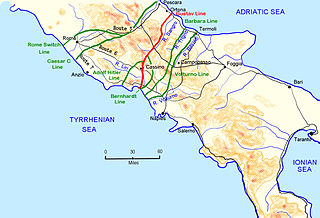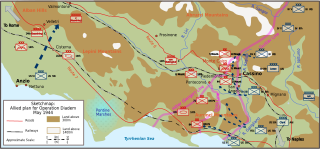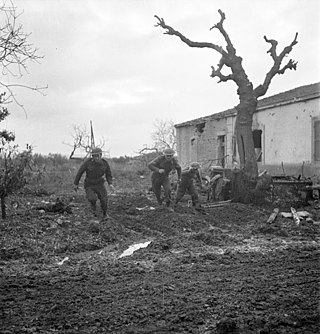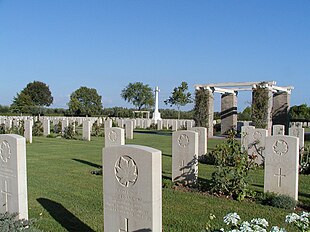
The Battle of Monte Cassino, also known as the Battle for Rome, was a series of four military assaults by the Allies against German forces in Italy during the Italian Campaign of World War II. The objective was to break through the Winter Line and facilitate an advance towards Rome.

The Battle of Anzio was a battle of the Italian Campaign of World War II that took place from January 22, 1944. The battle began with the Allied amphibious landing known as Operation Shingle, and ended on June 4, 1944 with the liberation of Rome. The operation was opposed by German and by Italian Repubblica Sociale Italiana (RSI) forces in the area of Anzio and Nettuno.

During the Italian Campaign of World War II, the Barbara Line was a series of German military fortifications in Italy, some 10–20 mi (16–32 km) south of the Gustav Line, from Colli al Volturno to the Adriatic Coast in San Salvo and a similar distance north of the Volturno Line. Near the eastern coast, it ran along the line of the Trigno river. The line mostly consisted of fortified hilltop positions. The line was broken by the allied army in November 1943 following which the Axis forces withdrew to the defensible positions of the Winter Line.

The Garigliano is a river in central Italy.

The Bernhardt Line, or Reinhard Line, was a German Army defensive line in Italy during the Italian Campaign of World War II. Having reached the Bernhardt Line at the start of December 1943, it took until mid-January 1944 for the US Fifth Army to fight its way to the next line of defences, the Gustav Line. The Bernhardt Line was defended by XIV Panzer Corps, part of the German Tenth Army.
The Battle of Cisterna took place during World War II, on 30 January–2 February 1944, near Cisterna, Italy, as part of the Battle of Anzio, part of the Italian Campaign. The battle was a clear German victory which also had repercussions on the employment of U.S. Army Rangers that went beyond the immediate tactical and strategic results of the battle.

The Allied invasion of Italy was the Allied amphibious landing on mainland Italy that took place from 3 September 1943, during the Italian campaign of World War II. The operation was undertaken by General Sir Harold Alexander's 15th Army Group and followed the successful Allied invasion of Sicily. The main invasion force landed on the west coast of Italy at Salerno on September 9 as part of Operation Avalanche, while two supporting operations took place in Calabria and Taranto.

The Volturno Line was a German defensive position in Italy during the Italian Campaign of World War II.

The Italian campaign of World War II, also called the Liberation of Italy following the German occupation in September 1943, consisted of Allied and Axis operations in and around Italy, from 1943 to 1945. The joint Allied Forces Headquarters (AFHQ) was operationally responsible for all Allied land forces in the Mediterranean theatre and it planned and led the invasion of Sicily in July 1943, followed in September by the invasion of the Italian mainland and the campaign in Italy until the surrender of the German Armed Forces in Italy in May 1945.

The 90th Light Infantry Division was a light infantry division of the German Army during World War II that served in North Africa as well as Sardinia and Italy. The division played a major role in most of the actions against the British Eighth Army in the Western Desert Campaign and eventually surrendered to the Allies in the final stages of the Tunisia Campaign in May 1943. It was re-constituted later in 1943 and deployed to Sardinia and when the expected Allied invasion of Sardinia failed to materialise, the division was moved to Italy. It was engaged in actions against the Allies in Italy from 1943 to April 1945 when the division was listed as "destroyed" in the Po River valley.

The Battle of Monte La Difensa took place between 3 December and 9 December 1943 during Operation Raincoat, part of the Battle for the Bernhardt Line during the Italian campaign in World War II.

Operation Diadem, also referred to as the Fourth Battle of Monte Cassino or, in Canada, the Battle of the Liri Valley, was an offensive operation undertaken by the Allies of World War II in May 1944, as part of the Italian Campaign of World War II. Diadem was supported by air attacks called Operation Strangle. The opposing force was the German 10th Army.

The 44th Infantry Division was formed on 1 April 1938 in Vienna, about two weeks after the Anschluss of Austria. It first saw combat at the start of the war in the Invasion of Poland, and also took part in the Battle of France in 1940. After a 9-month period of coastal defence the division was transferred East. On 22 June 1941, the division took part in the invasion of the Soviet Union, attached to Army Group South. It remained in the east after the failure of "Operation Barbarossa", taking part in defensive actions for the winter against the Soviet Army offensives near Izum and Kharkov. Refurbished, the division participated in the German summer offensive, and was subsequently destroyed with the 6th Army at Stalingrad in January 1943.

The Battle of San Pietro Infine was a major engagement from 8–17 December 1943, in the Italian Campaign of World War II involving Allied forces attacking from the south against heavily fortified positions of the German "Winter Line" in and around the town of San Pietro Infine, just south of Monte Cassino about halfway between Naples and Rome.

The Trasimene Line was a German defensive line during the Italian Campaign of World War II. It was sometimes known as the Albert Line. The German Commander-in-Chief (C-in-C), Generalfeldmarschall Albert Kesselring, used the line to delay the Allied northward advance in Italy in mid June 1944 to buy time to withdraw troops to the Gothic Line and finalise the preparation of its defenses.

The Moro River campaign was an important battle of the Italian campaign during the Second World War, fought between elements of the British Eighth Army and LXXVI Panzer Corps of the German 10th Army. Lasting from 4 December 1943 to 4 January 1944, the campaign occurred primarily in the vicinity of the Moro River in eastern Italy. The campaign was designed as part of an offensive launched by General Sir Harold Alexander's Allied 15th Army Group, with the intention of breaching the German Army's Winter Line defensive system and advancing to Pescara—and eventually Rome.

The spring 1945 offensive in Italy, codenamed Operation Grapeshot, was the final Allied attack during the Italian Campaign in the final stages of the Second World War. The attack in the Lombard Plain by the 15th Allied Army Group started on 6 April 1945 and ended on 2 May with the surrender of German forces in Italy.

I Canadian Corps was one of the two corps fielded by the Canadian Army during the Second World War.

The Battle of Rapido River was fought from 20 to 22 January 1944 during one of the Allies' many attempts to breach the Winter Line during the Italian Campaign of World War II. Despite its name, the battle occurred on the Gari River.
The I Fallschirmkorps was one of the main German Luftwaffe Corps during World War II.

















